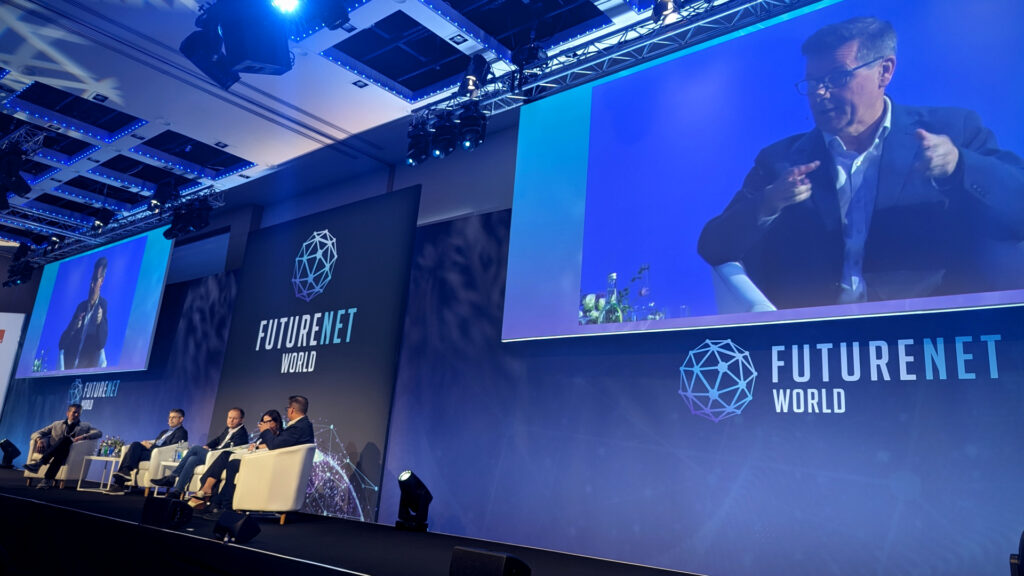In sum – what to know
Outward reinvention – top telcos discuss the task to go from rigid inward-focused network operations to agile outward-focused service supply – as prompted and hastened by AI.
Differentiated services – while the tech (5G SA) is mostly in place, there remain questions for the sector about resiliency and value – and also just about demand.
Industrial drive – the value of connectivity for critical industry is finally recognized, but telcos still need to build trust and ensure quality – and command their own narrative.
Whether by using AI or by supporting it, FutureNet World in London (May 7-8) is about the same stuff as every other telco event at the moment: telcos talking about telcos in pursuit of their own reinvention. Or digital transformation or industrial change, or network as-a-service, or platform as-a-service – whatever you call it, as now prompted and hastened by AI. Which is not to trivialise the importance or urgency of the task; as Colin Bannon, chief technology officer at BT Business, put it in a pe-lunch panel, it is about “a past that needs to be changed”.
The discipline is to break the industry’s “tightly-integrated vertical stovepipe portfolios”, traditionally “glued together to create solutions”, into “more horizontal capabilities” to engender the kind of service flexibility that allows telcos to go at the same pace as the rest of the digital economy – which has grown-up in its wake. As Laurent Leboucher, group chief technology officer at Orange said on the same panel, it is about how telcos change from being “inside-out to being outside-in” – which, at least in terms of differentiated quality-of-service, is possible “only with AI”, he said.

Both Bannon and Leboucher were on an early mid-morning session, as well, which asked just this: whether the original promise of 5G, to go “beyond connectivity” to deliver differentiated network services, particularly for enterprises, has been realised. Are we there yet? This was the question from the panel chair, Peter Jarich, head of GSMA Intelligence at the GSMA. Leboucher responded: “We’re not there. Definitely [not]. If you look at different approaches around the world, very few are really monetizing connectivity in a way that is differentiated. There are a few, but very few.” Telcos have to solve new technical challenges from new traffic demands, he suggested.
“A very significant part of active content today is generated by AI. A very significant part of the traffic is also generated by AI. That will be the case, increasingly – which means not just traffic for humans, but traffic for AI… We talk a lot about the access network, but it’s also about the backbone – which also has to take that kind of traffic into account, [and to serve] different requirements in terms of quality of service. A lot of traffic [until now has been served by a] best-approach [network]… That can’t be the case anymore… and this is really what we have to address today,” explained Leboucher.
Next to him, Jeanie York, chief technology officer at Virgin Media O2, disagreed – ostensibly. The platform is in place, she said; rather, the industry has challenges with its adoption and monetization. She responded: “We are there, I think. The underlying tech is definitely there with 5G SA… The problem for the last five years [has been that] we’ve spent billions on [the network without] being able to monetize [it]. But with relatively good 5G SA coverage, you have that capability [now] – whether with privatization in manufacturing or… a differentiated premium experience for football fans at the match on Saturday. We have the capability.”
AI, meanwhile (all the while), is one of the “foundational components” to activate and manage such differentiated services, she said. Despite this, York suggested the overall connectivity experience has not changed much in recent years, and reliability and availability – especially for critical enterprise operations, which remains the first-mover on SA-type capabilities, whether in private or public 5G infrastructure – remain critical areas for improvement. What is more and more important beyond the technology component is the fact that we still have a long-ways to go to make sure that connectivity is reliable and available anytime and anywhere for consumers and businesses,” she said.
Bannon at BT pointed to a “value gap”, increasingly recognised by enterprises, between services rendered and value received. “It is a systemic issue for the whole industry,” he said. “Most businesses… do not have a plan B without some form of connectivity. You still have this in patches… where billions of pounds of transactions [are] running over [a connectivity service] enterprises are only paying thousands of pounds for – where they haven’t invested in resilience or quality of service or slices, or whatever.” Sharp-elbowed cloud providers have hogged the narrative about resiliency and value, he suggested; the plot twist with SA and AI is telcos are being ushered back to the stage.
“Cloud service providers have done a brilliant job with that narrative… [to] attach value to their services. Telcos have to close that gap. [But] where you might argue the cloud providers were gaslighting the industry, saying [to enterprises] that the cloud will just work by itself, they are now saying the network really, really matters,” argued Bannon, going on to talk about the importance of trust and credibility in light of geopolitical uncertainty, and in the context of the industry’s record for sovereign national service provision. “We’re running the air traffic control, the emergency services, the hospitals; we’re protecting the banks, we’re protecting the nation.”
And as such, that value gap is indeed closing, he suggested. “When [enterprise] procurement teams do their evaluation now, they are considering quality and resiliency and differentiation rather than just cost,” he said. “It is incumbent on the industry to… bridge that [narrative] gap… [about] the importance of the network… as part of that overall operational resilience equation.” The case had been put variously, but the question came again: about whether consumers and enterprises – and the rest of the tech ecosystem – still thinks of networks as “utility), or whether the perception has shifted to recognize its strategic importance.
It is symptomatic of the industry’s existential identity crisis of course – just to keep asking the question. This time, in London, the question went to the only non-telco on the panel: Oleg Volpin, president in the European networks division at telco service provider Amdocs. The answer is ‘no, definitely not’ – he reassured the room. People properly understand the critical role of connectivity, he said, and pointed to the power outage last week in Spain, suggesting the consequent network outage (bar satellite) would have been more keenly felt than the electric blackout itself. At the same time, the industry has work to do to make connectivity work well and reliably.
“We need to find this balance and to make it work,” he said.

